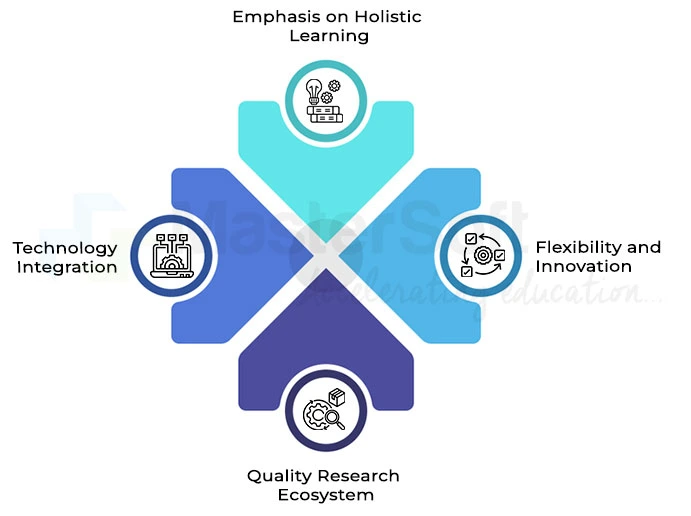21, Dec 2023
In the wide and varied world of higher education in India, accreditation acts like a helpful guide, making sure that educational institutions measure up to set standards of quality and excellence. It forms the base for making education great and always getting better.
It helps institutes stay on the right track and ensures that they're providing quality education. It's an ongoing process that encourages institutions to keep improving. Accreditation is like the backbone of the education system – it gives it structure and supports the continuous growth of quality education.
In simpler terms, accreditation is like a friendly guide for colleges and universities. It's there to make sure they're doing a good job and meeting certain quality standards.
Let's learn more about university accreditation and how it offers a clear path to educational quality.
What Is The NBA Accreditation And Why Does It Matter?
Understanding Accreditation in India-
What is Accreditation?
Accreditation is a systematic process that evaluates educational institutions to ensure they meet established quality benchmarks. In India, accreditation is carried out by autonomous bodies such as the National Board of Accreditation (NBA) for technical institutions and the National Assessment and Accreditation Council (NAAC) for universities and colleges.
It gives a high form of recognition to the colleges and universities gaining trust from the students and organizations.
The Accreditation Process

The accreditation process is a comprehensive evaluation of various aspects of an educational institution. It typically involves a rigorous self-assessment by the institution, followed by an external peer review. The assessment covers factors such as infrastructure, faculty quality, curriculum, student outcomes, and overall institutional management. It can be easily managed by an accreditation data management system (ADMS).
1. Preparation:
Self-Study Report (SSR): The institution undergoing accreditation begins by conducting a comprehensive self-assessment. This involves a thorough examination of various aspects, including academic programs, faculty qualifications, student services, infrastructure, governance, and more.
The findings are documented in a Self-Study Report (SSR). The SSR provides a detailed account of the institution's strengths, weaknesses, achievements, and areas for improvement.
2. Peer Review:
Selection of External Experts:
Accrediting bodies typically appoint a team of external experts, often referred to as peer reviewers or evaluators. These individuals are professionals with expertise in relevant fields, and they are not affiliated with the institution being evaluated. The selection process ensures objectivity and impartiality.
On-Site Visits:
The external experts visit the institution in person to conduct on-site evaluations. During the visit, they may tour facilities, observe classrooms, meet with faculty, staff, and students, and assess various aspects of the institution's operations. This on-site component allows the peer reviewers to validate the information presented in the SSR and gain a firsthand understanding of the institution's strengths and challenges.
Interactions with Stakeholders:
Peer reviewers often engage in interviews and discussions with various stakeholders, including administrators, faculty members, students, and community representatives. This allows them to gather diverse perspectives on the institution's performance and impact.
Validation of SSR:
The external experts compare the information in the SSR with their on-site observations and stakeholder interactions. They assess whether the institution is meeting the established standards and criteria for accreditation.
3. Decision:
Evaluation and Rating:
After the on-site visit and a thorough review of the SSR, the accrediting body evaluates whether the institution meets the established standards. This evaluation may result in the assignment of a rating, grade, or accreditation status. The rating could indicate the level of compliance with the accrediting body's standards, and it may also highlight specific areas for improvement.
Decision on Accreditation:
Based on the evaluation, the accrediting body decides whether to grant accreditation to the institution. This decision considers the overall quality and effectiveness of the institution in delivering education and services. If the institution meets the required standards, accreditation is granted, and the duration of accreditation may be specified (e.g., accreditation for a certain number of years).
Feedback and Improvement:
Accrediting bodies often provide feedback to institutions, even if accreditation is granted. This feedback may include commendations for strengths and recommendations for improvement. Institutions are expected to use this feedback to enhance their quality and make necessary improvements in areas identified during the accreditation process.
Overall, the accreditation process is designed to ensure continuous improvement in educational institutions and to maintain and enhance the quality of education provided to students. The accreditation data management system is a one-stop solution for all accreditation-related processes.
MasterSoft's Outcome-Based Assessments: Easy Accreditation For Institutional Growth
Accreditation: Paving a Clear Path to Educational Quality
Let's delve into how accreditation benefits students with a recognized education and institutions with a mark of quality and adherence to rigorous standards.
For Institutions
1. Quality Improvement- The accreditation process provides institutions with valuable insights into their strengths and weaknesses, encouraging a culture of continuous improvement.
2. Global Recognition- Accreditation enhances the reputation of institutions, making them more attractive to students and faculty on a national and international scale.
3. Funding Opportunities- Accredited institutions are often eligible for government grants and funding, supporting their growth and development.
For Students
1. Quality Assurance- Accreditation assures students and parents that the institution maintains high standards of education, ensuring a valuable and reputable learning experience.
2. Employability- Degrees from accredited institutions are generally more recognized and respected by employers, giving students a competitive edge in the job market.
3. Transferability of Credits- Accreditation facilitates the smooth transfer of credits between institutions, allowing students greater flexibility in their academic journey.
The Role of NEP 2020 in Accreditation

The National Education Policy (NEP) 2020, a landmark reform in India's education sector, plays a pivotal role in reshaping the accreditation landscape. Here's how NEP 2020 influences and complements the accreditation process-
Emphasis on Holistic Learning-
NEP 2020 encourages a shift towards holistic and multidisciplinary education. Accreditation bodies now evaluate institutions not only on traditional academic parameters but also on their ability to provide a comprehensive and well-rounded educational experience.
National Education Policy 2020: All You Need To Know About NEP 2020 For Schools
Flexibility and Innovation-
The policy promotes flexibility in curriculum design and encourages innovative teaching methods. Accreditation processes, aligned with NEP 2020, now consider how institutions embrace these aspects to foster creativity and critical thinking among students. The university management system simplifies and helps in aligning the expectations and actions in the institutes.
Quality Research Ecosystem-
NEP 2020 emphasizes the development of a robust research ecosystem. Accreditation criteria have been updated to evaluate an institution's commitment to research, promoting a culture of inquiry and discovery.
Technology Integration-
In line with NEP 2020's vision of harnessing technology for education, accreditation processes now assess how institutions leverage technology for teaching, learning, and administration, ensuring they are equipped for the demands of the digital era.
Challenges and Opportunities-
While accreditation brings numerous benefits, it is not without challenges. Some institutions may find the process resource-intensive and time-consuming. However, these challenges are outweighed by the long-term advantages, and the accreditation process continually evolves to become more streamlined and efficient.
Also, the introduction of an accreditation data management system has automated the processes and enhanced communication among various departments in the institute.
Conclusion-
Accreditation in India is not merely a bureaucratic formality but a dynamic process that shapes the future of higher education. As institutions align with the evolving educational landscape, accreditation serves as a compass, guiding them toward excellence and continuous improvement.
The integration of NEP 2020 into the accreditation framework further strengthens the commitment to quality education and prepares institutions and students for the challenges and opportunities of the 21st century.
In this journey towards educational quality, accreditation emerges not only as a regulatory measure but as a collaborative effort between institutions, accrediting bodies, and policymakers.













